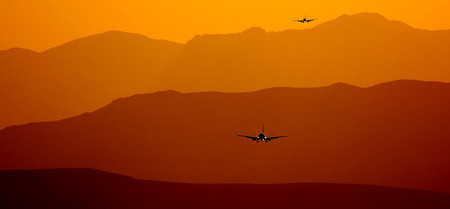Air advisory stays in effect through today
Smoke and foul air from wildfires in Southern California will continue to drift into the Las Vegas Valley and elsewhere in Clark County, where local air quality officials have extended an advisory through today for people with respiratory conditions.
The advisory alerts people with those conditions as well as children and the elderly to stay indoors to avoid health problems from inhaling polluted air.
On Tuesday, the Clark County Department of Air Quality and Environmental Management urged residents to sign up for an e-mail "EnviroFlash" that will send air quality information to their in-boxes. They can sign up for the e-mail service at www.accessclarkcounty.com.
"With a steady stream of smoke coming into the valley from the Southern California wildfires, it is easy to be aware that the quality of our air is presently not pristine. But shouldn't we think about the air quality every day?" the department news release says.
Local urgent care clinics have not noticed an increase in patients complaining of respiratory problems linked to the fires, said Danita Cohen, spokeswoman for University Medical Center.
Since Sunday, the smell of charred wood and vegetation have emanated from the foul air that's laced with soot, dust and carbon particles as well as ozone-forming compounds such as nitrogen oxides and sulfur dioxides.
Air quality spokeswoman Brenda Williams said the advisory extends to "children who play team sports outside or people who work and exercise outside. They should be careful about it and probably take their activities inside until the smoke subsides."
Williams suggested that sensitive groups, especially people with heart and respiratory conditions, should stay inside, close windows and doors, and keep air conditioners on.
The air quality forecast for today calls for moderate levels of ground-level ozone, dust, smoke and soot. Carbon monoxide is expected to stay in the "good" range.
On Thursday, ozone, carbon monoxide, dust smoke and soot are all expected to be in the "good" range at monitoring sites in and around the Las Vegas Valley.
Phillip Wiker, meteorologist for the Department of Air Quality and Environmental Management, said coarse particulate matter "that you can see is usually not bad for you. Your sinuses and your lungs will be able to get rid of that."
He said the culprits are fine particles that "get lodged down far enough in your lungs that your body can't rid ... similar to cigarette smoke."
The air quality index for various pollutants is divided into six levels -- good, moderate, unhealthful for sensitive groups, unhealthful, very unhealthful and hazardous.
Wiker noted that the ratings at various sites are based on 24-hour averages.
"It's not an instantaneous thing. It's prolonged exposure" that affects the general population, he said.
The moderate rating by the Environmental Protection Agency is for levels of air pollutants for which people in sensitive groups -- those with heart and respiratory conditions, the elderly and children -- should consider curtailing outdoor activities.
"It's not until you reach the unhealthful range for the general population before healthy people start to see effects," Wiker said.
Wildfires hundreds of miles away in Los Angeles and Hemet have injected fine dust particles and soot into the atmosphere as well as ozone from burning brush, trees and vegetation.
In recent years, wildfires in Southern California have prompted smoke and ozone warnings in Las Vegas.
On Oct. 29, 2003, smoke from California wildfires 230 miles southwest of the valley blew across Southern Nevada, covering the Las Vegas skyline with an eerie, gray shroud of unhealthful air that dimmed the noontime sun down to a peach-colored ball.
An air quality advisory was issued June 20, 2006, and two other times that summer from smoke from a wildfire in Santa Barbara.
Contact reporter Keith Rogers at krogers@reviewjournal.com or 702-383-0308.
STATE AGENCY'S FIREFIGHTERS GO TO CALIFORNIA
Four local firefighters from the Nevada Division of Forestry have been dispatched to help firefighters in Southern California, but there are no plans to send city or county firefighters.
The four firefighters were from Lee Canyon and were sent Saturday with a 650-gallon brush engine, division spokesman Mark Blankensop said.
They join 12 forestry firefighters with three fire engines from Northern Nevada and a division supervisor with the Bureau of Land Management.
Dry conditions in Southern Nevada have kept the county from sending fire crews to the blaze burning north of Los Angeles.
"They felt that with everything as dry as it is that we want our manpower here," Clark County Fire Department spokesman Scott Allison.
Blankensop said there have been several lightning-sparked fires in rural areas this summer, but they have been small and quickly contained.
LAS VEGAS REVIEW-JOURNAL

















